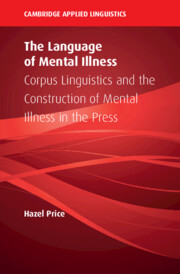 The Language of Mental Illness
The Language of Mental Illness Book contents
- The Language of Mental Illness
- The Cambridge Applied Linguistics Series
- The Language of Mental Illness
- Copyright page
- Dedication
- Contents
- Figures
- Tables
- Acknowledgements
- 1 Introduction
- 2 The Language of Mental Illness
- 3 Analytical Method 1
- 4 Analytical Method 2
- 5 Corpus Construction
- 6 The Shifting Meaning of Mental Health and Mental Illness
- 7 Named, Labelled and Referred to: People with Mental Illness in the MI 1984–2014 Corpus
- 8 ‘Suffering’ Illnesses and ‘Experiencing’ Symptoms
- 9 Do Newspaper Reports Accurately Represent the Symptoms of Mental Illness?
- 10 Conclusion
- References
- Index
7 - Named, Labelled and Referred to: People with Mental Illness in the MI 1984–2014 Corpus
Published online by Cambridge University Press: 05 May 2022
- The Language of Mental Illness
- The Cambridge Applied Linguistics Series
- The Language of Mental Illness
- Copyright page
- Dedication
- Contents
- Figures
- Tables
- Acknowledgements
- 1 Introduction
- 2 The Language of Mental Illness
- 3 Analytical Method 1
- 4 Analytical Method 2
- 5 Corpus Construction
- 6 The Shifting Meaning of Mental Health and Mental Illness
- 7 Named, Labelled and Referred to: People with Mental Illness in the MI 1984–2014 Corpus
- 8 ‘Suffering’ Illnesses and ‘Experiencing’ Symptoms
- 9 Do Newspaper Reports Accurately Represent the Symptoms of Mental Illness?
- 10 Conclusion
- References
- Index
Summary
Chapter 7 explores the labels associated with mental illness in more detail, specifically through naming analysis. I discuss prescribed forms for referring to people with mental illness (such as person-first language) and explore the frequency of such prescribed forms in the corpus. In addition, salient naming strategies in the corpus, particularly the labels ‘patient’, ‘sufferer’ and ‘victim’ are investigated. Using corpus evidence, I show that these labels are patterned to specific illness types. Furthermore, I argue that the tendency in the corpus to refer to people as quantities and statistics depersonalises people with mental illness. I argue that the ‘rhetoric of quantification’ (Fowler, 1991: 166) provides a way for the press to sensationalise news events related to mental illness which in turn constitutes the representation of mental illness as a ‘moral panic’ (Cohen, 1973).
Keywords
- Type
- Chapter
- Information
- The Language of Mental IllnessCorpus Linguistics and the Construction of Mental Illness in the Press, pp. 156 - 197Publisher: Cambridge University PressPrint publication year: 2022
